Looking like some sort of hairy sea urchin, rambutan is a fruit widely eaten in Asia. It’s now also grown in Central American countries and Australia. The juicy and sweet white flesh is hidden under the fruit’s spiky exterior covered with tiny hairs.

This post will go through all you need to know about this unusual exotic fruit. Covered below is what it tastes like, how to choose a good one, the health benefits, how to peel it and more. Let’s dive into the tropical world of the rambutan!
What is a Rambutan?
The name of the rambutan comes from ‘rambut’, a Malaysian word that means ‘hairy’. And so it is – the rambutan – or Nephelium Lappaceum – does indeed have a distinctive hairy skin.
A rambutan fruit is somewhere between yellow and red on the color spectrum. The shape is either round, like an orange, or more flattened, like a mandarin. On the outer skin you’ll also find the green or yellow tendrils that give the fruit its characteristic hairy appearance.
Inside a rambutan, it has white flesh surrounding a single seed. The flavor is a delicate balance between sour and sweet. Several varieties of rambutan are available.
Rambutans are endemic to certain parts of southeast Asia, namely Singapore and peninsular Malaysia. Today they are also cultivated in Central American countries, and sometimes also in Australia. A tropical climate with high humidity is just what they need to thrive.

A rambutan tree is rounded and thus more shrub-like in shape. This typically wide tree also has low branches and smooth bark. Individual specimens may reach 25 to 30 meters in height, particularly when they’re not pruned regularly.
Where to Buy it?
Rambutans are generally ripe for picking during December and January, and there may also be a second harvest in August and September. They can be found in southeast Asian and Chinese markets, especially when in season.
In the US, the popularity of the rambutan is growing. Fresh and canned rambutans can be bought in supermarkets, specialty food shops and grocery stores. You may be able to buy them all year round – especially in cities with a Chinatown – but they’re more plentiful during the harvest season.
Look for a rambutan that’s a darker red if possible. Paler ones may not be completely ripe, though this does depend on the variety. To ward off rot and damage caused by handling, rambutans are often sold with the branch they grew on.
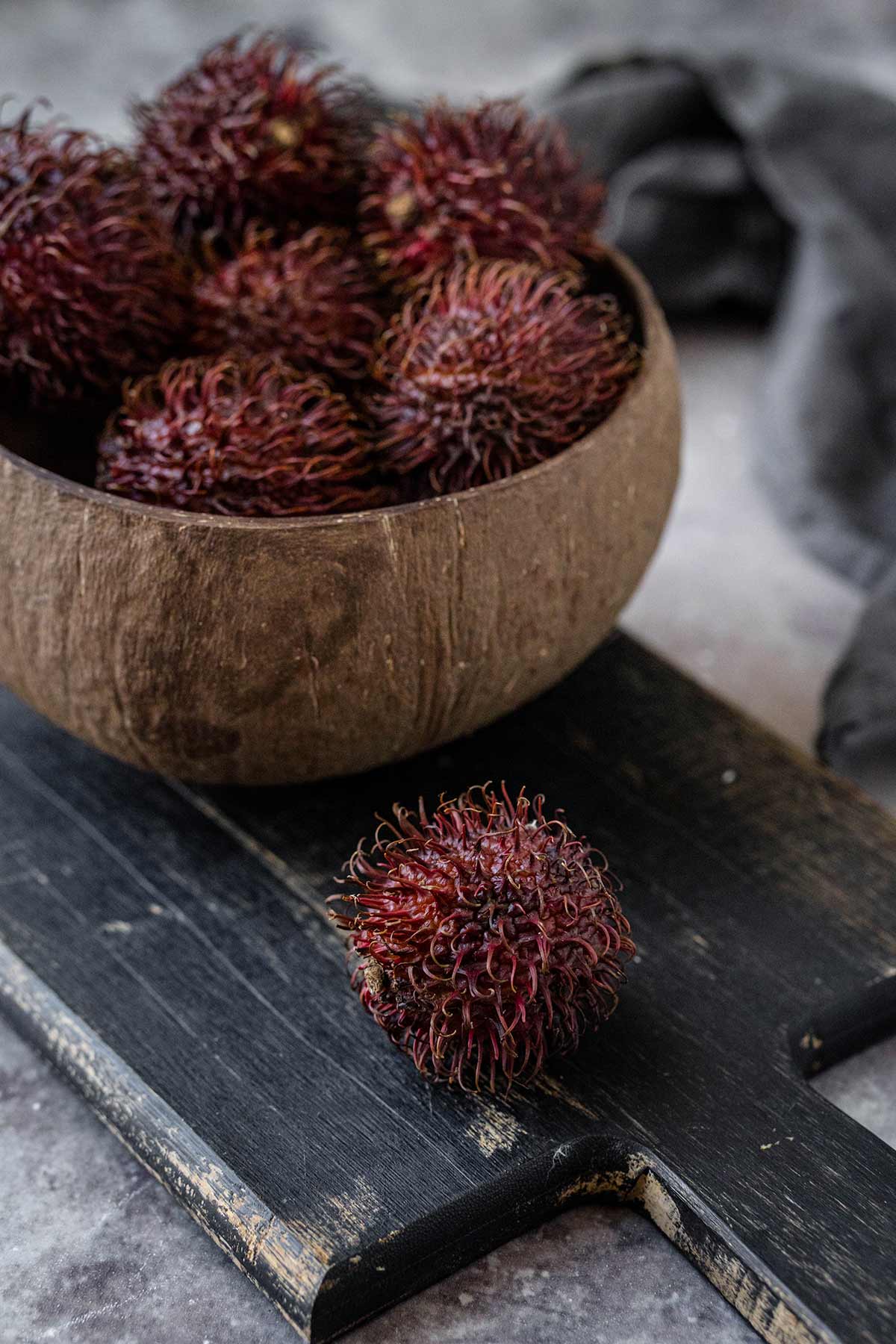
How to Pick the Perfect Fruit
If you’re buying rambutans outside of the countries they’re grown in, a long journey may have been involved. This means the fruit can be bruised or even rotting by the time it reaches locations like the US.
You therefore need to choose your rambutans carefully. Avoid green ones, as they won’t be ripe. Depending on the variety, though, those with only a little yellow, orange or red may be ready to eat. The tendrils should be green or yellow.
Check that the rambutan’s husk is still intact. If buying rambutans that have already been peeled, the flesh should be white. A nice sweet aroma should be detectable. If the rambutan smells fermented or gives off liquid, it’s best avoided.
What Does Rambutan Taste Like?
The flavor of a rambutan is sweet, but the fruit does also have sour notes. It tastes a little like a lychee or a longan, and in fact all three do belong to the same soapberry family.
A rambutan’s flesh is slightly chewy, with a creamy texture. Though it’s primarily sweet, there’s more sourness there than you’d find with a fruit like a grape. The flavor is sweet yet a little tart, with tropical and floral notes too.
Avoid the rambutan seed: it doesn’t taste good and is also toxic to humans.
Nutritional Value
Rambutan is one of those rare fruits known as a superfruit. It’s packed with good-for-you stuff.
A rambutan is high in dietary fiber, and rich in vitamin C. It also contains beneficial minerals including phosphorus, copper, manganese, folate, potassium, iron, magnesium and zinc.
This nutritional content means that eating rambutans may aid digestion, help with new cell growth and allow you to absorb iron more easily. The fruit may also support the immune system and heart health and work as an antioxidant.
Due to anti-inflammatory properties, consumption of this exotic fruit may also benefit people with chronic conditions like arthritis and diabetes.
How to Peel a Rambutan
Though they may look like spines, the tendrils on a rambutan are actually pretty soft. So they move easily when you split the skin apart for peeling.
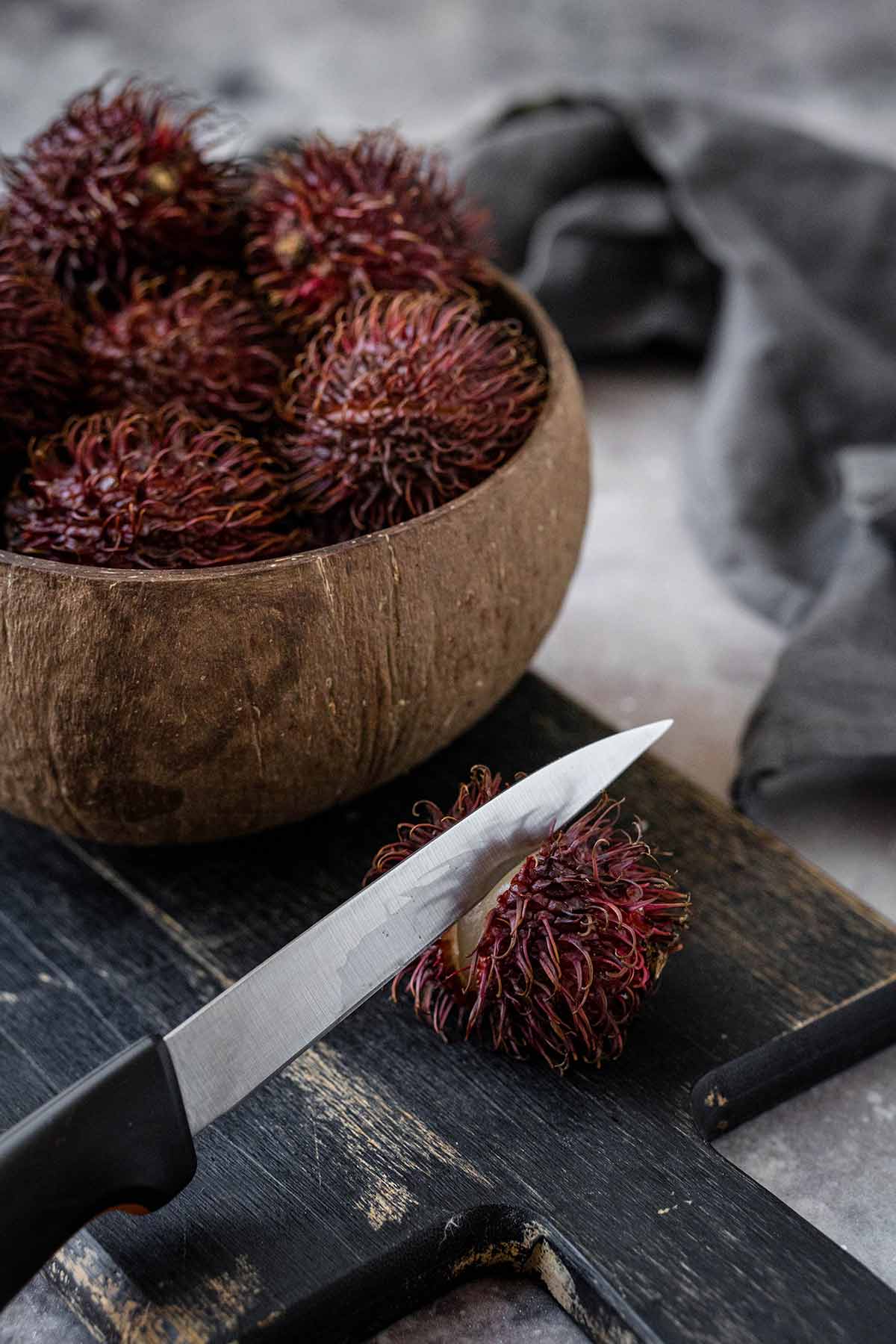
You can use your fingernails or a knife to pierce the outer casing. Once you’ve broken through the skin, you can squeeze out the edible part of the fruit. This is whitish in color and larger than a grape.
You can run a knife around the rambutan peel if you like, splitting it in half from the stem downwards. Try not to pierce the flesh at this point though.
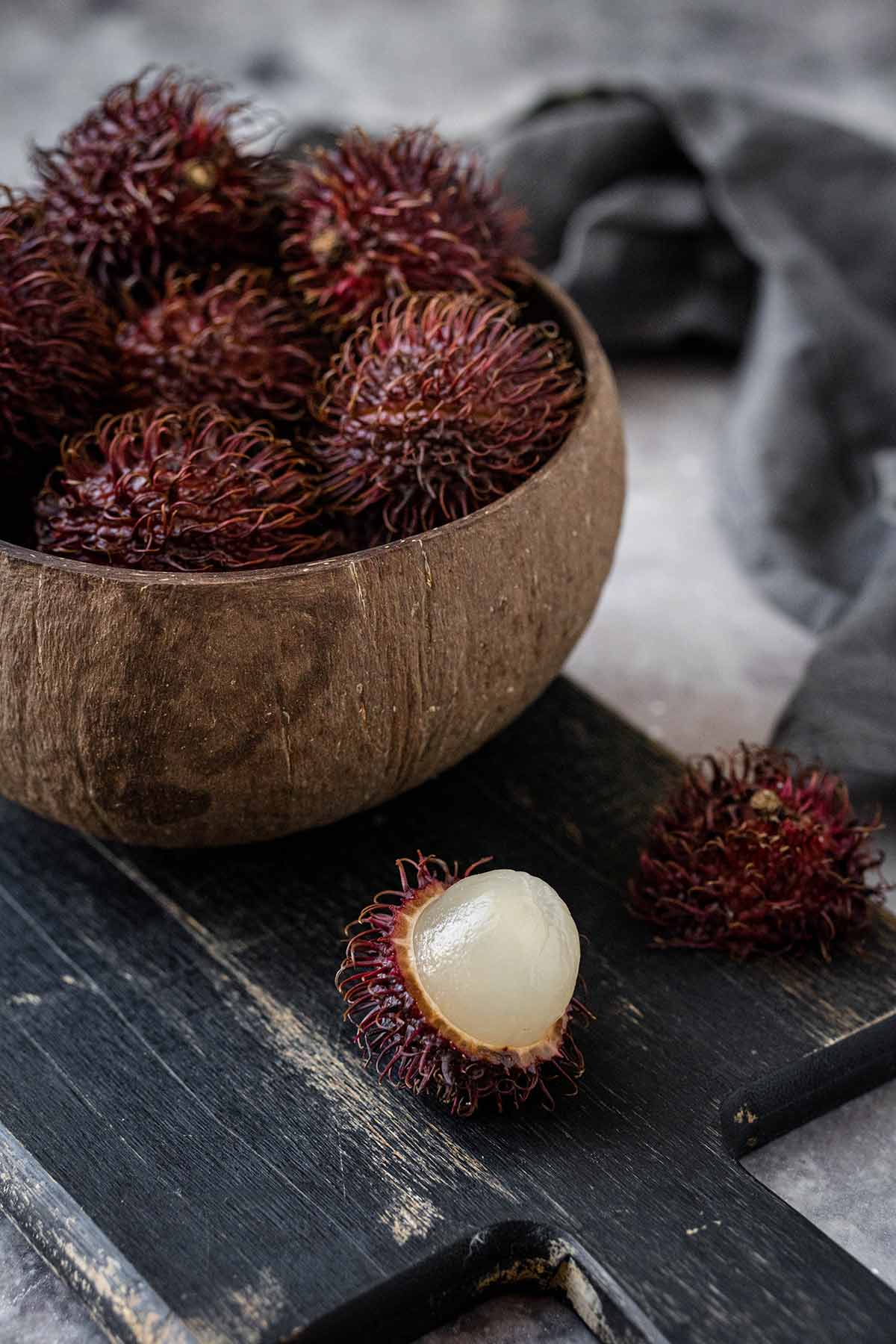
If you do want to remove the seed, make a small incision so you can then scoop this out with a spoon. Alternatively, just eat the flesh around the inner seed before discarding it.
How to Eat a Rambutan
Rambutan is available fresh, or in cans. It’s often eaten as a snack, or can be added raw to salsas, salads, smoothies or even cocktails. Rambutans may also be cooked to create jellies, sauces, ice creams, sorbets, marinades or sauces.

In the Philippines, rambutan seeds may be roasted before serving as a snack. Like other tropical fruits such as mango, they can also be added to curries. A rambutan also makes a good substitute if you cannot get hold of lychees.
Storage
Rambutans will stay fresh for longer if they’re refrigerated. Leave the skin intact, and wrap in kitchen paper. You can then place the unpeeled, wrapped rambutans inside a breathable bag or container.
Rambutans typically last for several days when stored at room temperature. When chilled, it may remain fresh for up to a fortnight. You can also freeze the fruit for use within three months.
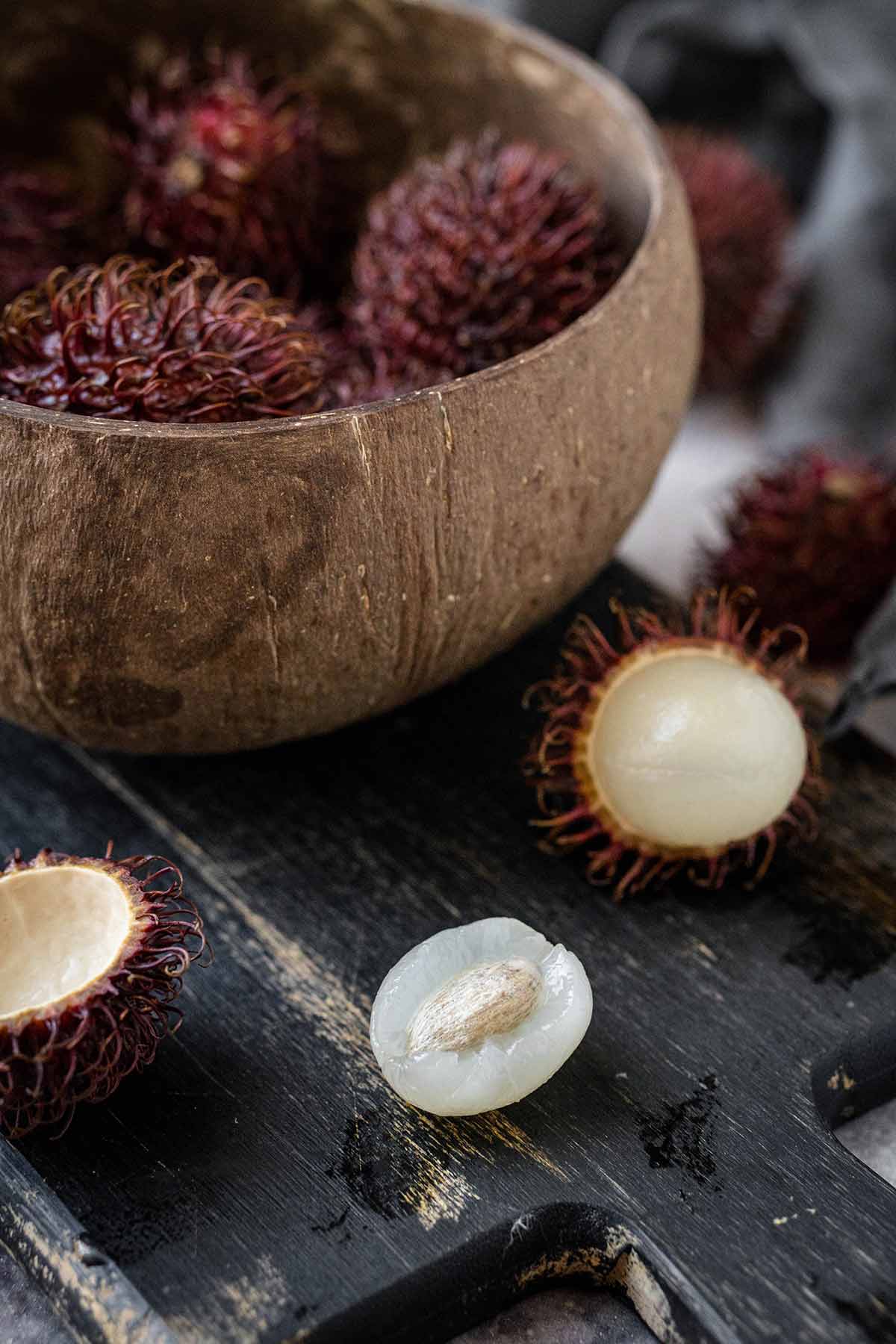
Rambutan FAQs
Eating up to half a dozen rambutans per day is perfectly fine. Excessive consumption can raise blood sugar levels, however, or might cause constipation.
Raw rambutan seeds should not be eaten – but roasted ones are eaten in countries such as the Philippines. The skin and the seed contain substances that can be toxic to humans, though. So it’s best not to eat them, as roasting may not completely destroy these.
The first obvious difference is a visual one. Rambutans are hairy, while lychees have a smooth but tendril-free skin. A rambutan is also sweeter than a lychee, with a flavor more like a strawberry.
Rambutans are a bit bigger than lychees. They also have a thicker skin, with the characteristic yellow or green tendrils.
Once you break into these fruits, they look more similar. Both have white flesh and a large central seed.
In terms of flavor, rambutan is rich and creamy in comparison. Lychees have more of a floral aroma, plus a crisper bite.
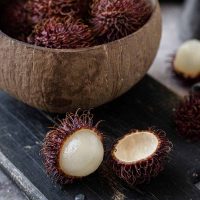
How to Eat a Rambutan
Ingredients
- Fresh rambutans
Instructions
- Use your fingernail or a sharp knife to pierce the rambutan's outer skin. Once you’ve broken through the skin, you can squeeze out the edible part of the fruit.
- If you do want to remove the seed, make a small incision so you can then scoop this out with a spoon. Alternatively, just eat the flesh around the inner seed before discarding it.
- That's it! Now you can enjoy your rambutan. Don't worry about the membrane that's stuck to the flesh – it's perfectly edible.

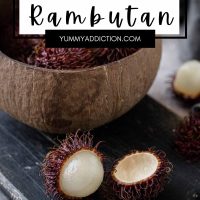
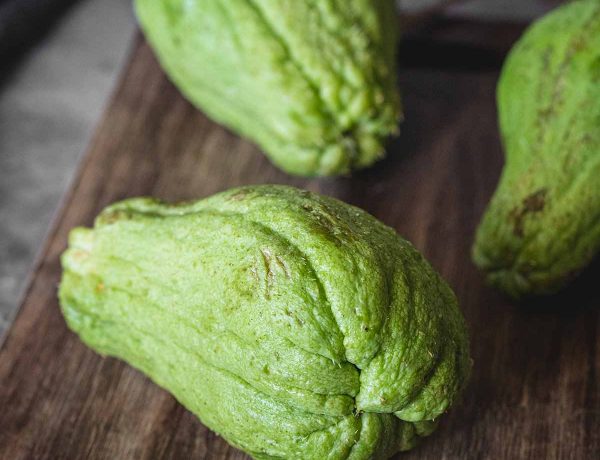
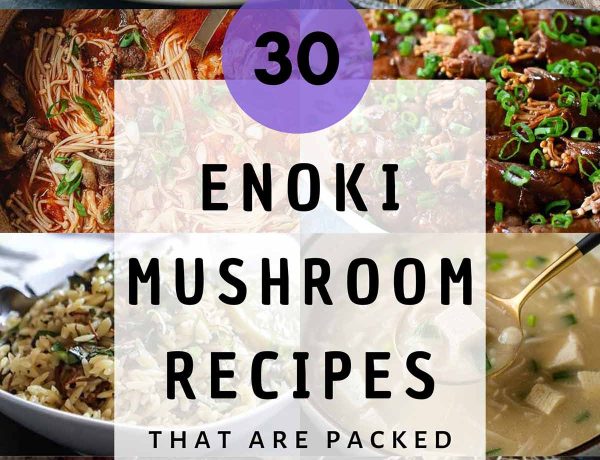
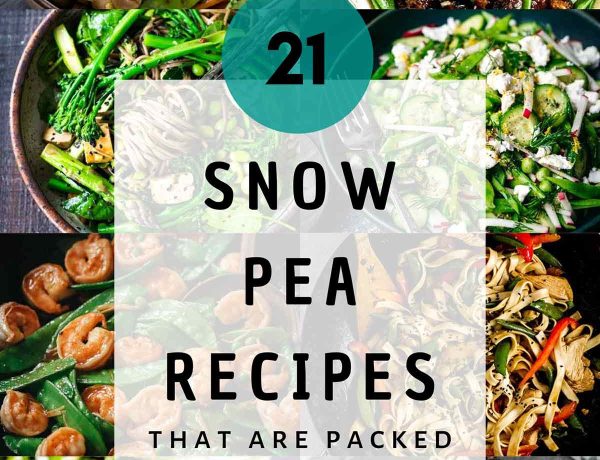
No Comments